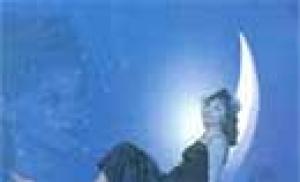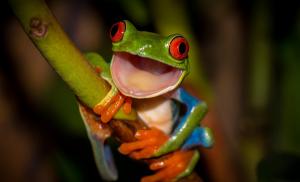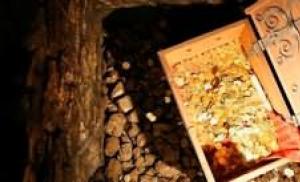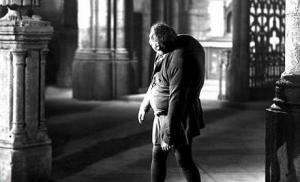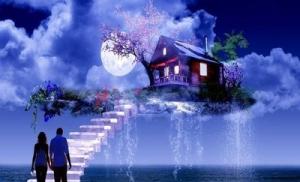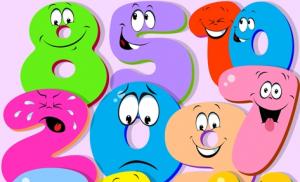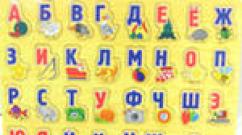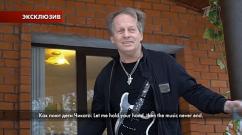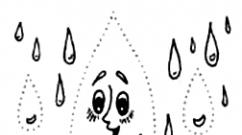Summary of the lesson conversation on the topic “Forest - multi-storey building” in the preparatory group. GCD on ecology in the preparatory group “Conversation about the forests of Siberia”
Municipal autonomous preschool educational institution combined type Kindergarten No. 9 “Alyonushka” in Birsk municipal district Birsky district of the Republic of Bashkortostan
Abstract
organized educational activities
on cognitive development
« Trees are our friends »
Prepared and conducted:
preparatory teacher
group No. 1 “Star”
Grishina Ekaterina Nikolaevna
Birsk 2017
Main educational area: cognitive development
Integration educational areas: speech development
Types of children's activities: communicative, cognitive-research, gaming.
Integrative goals and objectives.
TARGET: to form in children an idea of the need to respect nature.
Educational: clarify with the children the concept of “bark”, what it serves for a tree; learn to recognize by appearance tree, its age; fix the names of the professions of people involved in the study and care of forests, birds, and animals; expand children's knowledge about the benefits of trees.
Educational: develop speech and imagination; develop children's research skills.
Educational: cultivate a love for trees, a careful and caring attitude towards them.
Conditions for the implementation of educational activities.
Technical equipment: laptop (presentation)
Didactic material : pieces of tree bark (birch, spruce, linden, pine); pieces of resin, poplar branches; paper Brown, paper green leaves; diagram of dry wood, samples of objects made from birch bark, linden.
Preliminary work :
1. Tour of " ecological trail» kindergarten, with consideration of the color of the bark different trees, paying attention to the age of the tree, its species, size.
2. Watching birds sitting in trees.
3. Reading fiction(poems) about trees.
4. Conversation about the benefits of trees.
Progress of organized educational activities.
Organizing time.
Educator: Children, on the weekend I was in the forest and met a forester there. He gave me an envelope with a box for you. Let's read the letter and find out what it says (reads the letter with a riddle in it).
“In the rain and heat, a friend, green and good, will help us.
He will stretch out to us dozens of hands and thousands of palms" (Tree)
Educator: How did you guess that this was a tree? (children's answers) That's right, this is a tree (shows a picture). How can a tree help in rain and heat? What does the tree have? (roots, trunk, branches, leaves) What trees do you know? Can you name them? (Children's answers) Do you think the tree is alive or not?
Educator: Alive. Why do you think so? (children's answers) Correct. Because it, just like people and animals, breathes, eats, grows and reproduces.
Educator: How does a tree breathe?
Educator: That's right, leaves. A tree inhales dirty air, which is emitted by factories, factories, cars, and gives off oxygen - this fresh air necessary for human life.
Educator: Let's open the box and see what's in there(shows samples of bark, lays them out on the table).Children, what do you think this is?
Educator: That's right, it's bark. Why does a tree need bark? How do you think?
Educator: The bark protects the tree. What can she protect him from?
(From the sun, frost, wind, to prevent the juice from flowing out)
Educator: Do you think the bark only protects the trunk of the tree?
Children: No, and branches.
Educator: Let's see what the bark is and what is underneath it. Wood. The skin on the branches is thin, flexible, soft. We can easily separate it from the wood. And the tree trunk is covered with bark. It is tough and thick, and the skin is thin and soft.
(Looking at a tree cut with children)
Educator: The peel is a thin bark, only young. How do you think you can determine the age of a tree by looking at its bark? (Answers) True, the older the tree, the thicker and harder the bark. And also by the rings on the saw cut.
Educator: Let's look at the pieces of bark on this table. Find the bark young tree. Explain why you think so? What is she like?
Educator: Find the bark of an old tree. Explain why?
Educator: Why do you think a person needs to know the age of a tree? (To cut down old trees for firewood, for building houses, for making furniture, paper).
Educator: What trees need to be cut down in the forest, except old ones? (Sick)
Educator: How do you know if a tree is sick? (The leaves wither, the bark cracks).
Show 2.3 slides of the presentation.
Educator: Why do trees get sick? (Harmful insects have settled in.)
Educator: Look at the back of the bark, find where there are passages made by harmful insects, and show others (children find and show).
Educator: Who do you think heals the trees?
Educator: That's right, woodpecker. The woodpecker's tongue is serrated and sticky. When he pokes a hole in the trunk with his nose, he sticks out his tongue, and insects accumulate on the tongue or stick to it, and the woodpecker pulls them out of the trunk. Who knows what a woodpecker is called?
Children: Forest Doctor.
Educator: And trees also get sick because someone has cut the bark or broken a branch.
Educator: Yes, children, whoever does this brings great harm trees. The tree is crying. In early spring Many people collect birch sap: they make a cut and the sap flows out, collect the required amount and leave. And the juice continues to flow. After some time, a red stripe forms in this place. People say: “The birch tree cries tears of blood.” But few people know that after collecting the sap, it is necessary to cover the wound on the tree trunk with clay so that it does not die. Birch juice, children, very healthy, rich in vitamins.(presentation 4,5,6 slides)But in pine and spruce, the sap hardens in air, and resin is obtained.(slide 7)Let's smell some pieces of bark. (Birch, linden, elm, spruce, pine)
Educator:What do you think, children, what tree did our bark come from? From living or non-living? (From a sawn one).
Educator: Of course, from a cut tree that is prepared for firewood. There are special people who study and care for the forest, birds, animals and trees. Who knows what this profession is called?
Children: Forester.
Educator: So he knows which tree needs to be removed and what can be made from which tree.(Presentation on the benefits of trees)We told you that wood is used to build houses, to make furniture and paper. The buds and leaves are used in cosmetology and for making medicines. What else can be made from tree bark? Look at this exhibition, it will help you find the answers.
Children name products made from tree bark.
Educator: That’s right, various artistic crafts are made from tree bark. And back in ancient times, when there was no paper, people wrote letters on back side birch bark, and such a letter was called “Birch Bark Letter”. Bast shoes were woven from linden bark.
Educator: Bird commotion. Something happened in the forest. Birds circle over a tree (shows a diagram of a dry tree). What do you think happened to this tree? (It died).
Educator: Why did you decide that it died? (No bark, no leaves)
Educator: Let's help the tree, “dress” it.
(One child comes out and crumples brown paper, then sticks it to the trunk tree layout)
Educator: So we treated the tree. How else can we help him? Let everyone remember how trees help us, and what good, kind deeds we can thank them for. Each correct answer you give will turn into a green leaf on a tree.
Children name: they list the benefits of trees and how a person can care for them - water them, cover them with snow in winter, cover them with earth, make birdhouses for birds to fly in, collect beetles, cover wounds with clay...
The teacher, together with each child, glues a leaf to a mock-up tree.
Educator: Look, children, how our tree came to life. Birds flew to him.(Attaches to the model of a woodpecker, tit)Maybe they'll build nests and hatch chicks. Listen to how they sing.
The teacher plays a recording of birdsong.
Educator: The birds are singing merrily and joyfully.
OOD analysis:
Educator: You see how many interesting things we learned today. Trees are not only decorations of our land, but also our friends and helpers. So let's take care and protect them!
Topic: “Forest is the wealth of our region”
Purpose of educational activities: to clarify children’s ideas about the importance of forests in people’s lives.
Tasks:
Educational:
- To consolidate children's ideas about their native land, its wealth - the forest and its diversity, the role in the life of the animal world and humans.
- To consolidate the knowledge that plants are living beings that give us oxygen;
- Clarify the number of floors in the forest and the location of plants and inhabitants on the floors.
- Features of human use forest resources and their restoration.
- Clarify the rules of behavior in the forest.
Developmental : develop memory, attention, desire to learn something new; contribute to the development of aesthetic perception of the surrounding world.
Educational : Cultivate love for native land, careful attitude for use natural resources of your region. The ability to see the beauty of nature, cultivate interest in art: paintings, poems.
Vocabulary work: Activate children's vocabulary: Pinery, oak grove, birch grove, spruce forest, mixed forest, deciduous forest, coniferous forest.
Preliminary work:conversations about the forest, about plants, about animals. Looking at paintings and illustrations about the forest. Listening to the sounds of nature.
Progress of the lesson:
The teacher invites the children to close their eyes and listen carefully to the audio recording “The Sound of the Forest.”
Educator: guys, what did you hear just now? (answers)
Today we will talk about the forest - the wealth of our region.
I invite you to take a trip to Magic world forests, in vegetable world, and the “Miracle Tree” will help us with this, pay attention to the unusual leaves on it. But first, tell me, what does the tree have?
Let's remember what parts a tree has?(slide1)
- That's right, every tree has a root.
Problematic question: WHY DOES A TREE HAVE A ROOT?
(with the help of it the tree extracts nutrients, water from the ground, and it serves as an anchor for the tree). A tree has a trunk, branches, small twigs, leaves and fruits.(slide2)
Now let's let's pick a leaf from our Miracle Tree.
The tree offers to solve riddles about its tree friends.
Alenka is standing
Green scarf,
Slim figure
White sundress. (Birch)
(slide3)
Looking at a birch: How do we recognize a birch?
What does birch have? The bark is white, there are black lines, the birch breathes through them, they are called cherevichiki.
When only birch trees grow in a forest, what is such a forest called? (Birch Grove)(slide4)
We tear off the second leaf.
Majestic and mighty,
It grows on a steep slope,
With its jagged foliage
Shelters in the summer heat,
And when autumn comes,
He brings us an acorn as a gift. (oak)
(slide 5, 6)
Look what a thick trunk it has, what uneven, gnarled branches. What color is oak bark? It is not smooth, it is rough.
Not afraid of droughts and storms. Grows well even on rocky soil. By autumn, acorns ripen on the oak tree. Previously, bread was made from them. Now they go to feed livestock. Oak trees live up to 2000 years.
What is the name of a forest where there are only oaks? (Oak Grove or Dubrava)(slide7)
Let's take a closer look at oak acorns.(slide8) (give to children to review)
We tear off the third leaf.
You will always find HER in the forest -
You will go for a walk and you will meet.
Stands as prickly as a hedgehog,
In winter in a summer dress. (Spruce)(slide9)
Looking at spruce:
What can you tell us about the Christmas tree?
Its upper branches are young, and below are old and long. The bark is dark and rough.
Look at the forest where only spruce trees grow.(slide10) What is the name of such a forest? Elnik.
We tear off the fourth leaf.
I have longer needles
Than the Christmas tree
I'm growing very straight in height,
If I'm not on the edge,
The branches are only at the top of the head. (Pine)
(slide 11)
Looking at pine:
What kind of trunk does a pine tree have?
Light, golden. The old lower branches die off, so half the trunk is bare. Pines usually grow taller than spruces.
What is the name of a forest where only pine trees grow? (pine forest or pine forest).
(slide12)
Why are these trees green all year round?
What do spruce and pine have in common? (needles)
What is the name of the forest in which spruce and pine trees grow? (coniferous, since they have needles and needles).(slide13)
What is a forest with deciduous trees called?(slide14)
What is the name of a forest in which both conifers and deciduous trees? (Mixed)(slide15)
Phys. Just a minute
In the morning the children went to the forest
In the morning the children went to the forest (steps with legs raised high)
And they found mushrooms in the forest (measured squat),
Bent over, collected (bending forward),
On the way we got confused (rhythmic spreading of arms to the sides).
Guys, do you know that in the forest there are also floors, like our houses.
(slide16)
3rd floor – trees such as pine.
2nd floor – bushes and low-growing trees.
1st floor - grass, mosses.
The basement is where the roots are located.
And since the forest is a multi-story building, there are residents on each floor.(slide17)
Insects live on the ground, various herbs, berries, and mushrooms grow. Some birds make nests right on the ground, in the grass, for example, nightingales and black-headed warblers. There are lizards' houses, hedgehogs, foxes digging. Under the ground are the homes of mice, moles and various insects. The inhabitants of the dungeon include earthworms, they loosen the soil. There are many bushes at the edge of the forest. Many birds, such as blackbirds, live in them. At the top, tits, woodpeckers, and squirrels make houses in hollows; above them, owls and other birds. In summer there are many residents on all floors.
(slide 18)
Why do you think it’s easier to breathe in the forest than in the city? (answers)
The forest is our green friend, our health resort. It cleans the air of dust and enriches it with oxygen. The forest air has healing properties. We are always in a good mood in the forest.
People are building sanatoriums, children's health camps in or near the forest.(slide 19,20)
How else do people use the resources of the forest? (make furniture, dishes, paper)(slide21,22,23,24,25,26,27)
People use many of the gifts of the forest, but the resources of the forest are not unlimited and people try to replenish what they take from it. How?
(slide28,29,30,31)
And now, since we came to visit the forest today, what do we need to remember?Rules of behavior in the forest!Now we will look various situations and tell us what rules we know.(slide 31,32,33,34,35,36,37,38,39,40,41)
(answers)
People are grateful to the forest and reflect their love and admiration in beautiful works of art: music, poetry, paintings...
(slide42,43,44)
“Birch Grove” by Kuindzhi, “Pines”, “Oaks”, “Bears” Shishkin
(slide45)
Be healthy green forest!
Stand in formal attire!
Desks, books and notebooks
You gave us a green forest.
So that it doesn't disappear forever
Forest beast and bird too,
Prosper, our good friend,
Be healthy green forest!
This concludes our journey. Did you like it? What do you remember most from this trip?
Setting up for further activities...
On the territory of our Motherland there are different forests: coniferous, deciduous and mixed.
Forests in which spruce, pines, larches, fir, and cedars grow are called coniferous. These tree species do not have leaves on their branches, but green needles - needles.
Birch, aspen, oak, linden, maple, and ash trees grow in deciduous forests. The branches of some trees (oak, maple, ash, etc.) are decorated with large, wide leaves, which is why such forests are called broad-leaved.
What kind of forests do you think are called mixed?
Right! In mixed forests, oaks and spruce, birch and pine, aspen and larch grow side by side, i.e. coniferous and broad-leaved trees.
There are three main types of forests: coniferous (20% of all forests in Russia), broad-leaved (30%) and mixed (50%).
Coniferous forests, in turn, are divided into: spruce forests (spruce forests), where spruce trees predominate; pine (pine forests), in which the main tree is pine; larch - the lightest of coniferous forests, their basis is larch; fir trees, in which there are most fir trees, and cedar trees (they are called cedar trees), where the main tree is cedar.
Broad-leaved forests are also divided into several types: oak forests - called oak forests (you probably already guessed that the main tree in an oak forest is mighty oak); birch - called birch forests (birch predominates in them); aspen - called aspen forests (there are most aspen trees here).
Questions
1. What forests are found on the territory of our country?
2. What tree species are coniferous?
3. What grows on the branches of coniferous trees - needles or leaves?
4. Which trees predominate in deciduous forests? Why are these forests called that?
5. What types deciduous forests You know?
6. Tell us about mixed forests. What trees grow in them?
Spruce forest
Let's talk in more detail about spruce and pine forests.
A spruce forest is sometimes called a spruce forest, and sometimes a spruce forest. The main tree in a spruce forest is spruce. I'm sure you are familiar with it. After all, a fluffy Christmas tree, decorated with sparkling balls, beads and garlands, is our New Year’s guest! It appears in our home before the winter holidays - New Year and Christmas - and brings a wonderful resinous aroma.
Listen to the poem.
New Year's Day
New Year's Day!
The snow is frosty, stinging,
The lights came on
On a fluffy Christmas tree.
The painted ball swayed,
The beads rang
Smells like forest freshness
From resinous spruce.
What do spruce trees look like?
Spruces are tall, powerful trees. They grow very slowly, but live long: 500 or 600 years. The branches and trunks of spruce trees are mossy, resinous, greenish-gray. They say about spruce: “In winter and summer, the same color.” After all, this conifer tree it is green at any time of the year, and its needles fall off once every five to seven years. If from an elegant forest edge, flooded with bright sunlight, enter the spruce forest, you will immediately find yourself in a greenish-humid twilight, you will feel coolness and freshness. Spruce forest is shady and humid. The trunks are covered with moss, lichens hang from the branches. Spruce trees are shade-tolerant trees; they like moist soil, but do not grow in dry places.
What plants surround the spruce in the forest?
Plants accustomed to living under the dense canopy of its prickly dark green paws, in dense shade. The ground in the spruce forests is covered with a soft continuous carpet of mosses. It is always green - in winter and summer: one looks like tiny palms, another resembles silky light green feathers, the third resembles reduced carved fern leaves.
Low blueberry bushes stand out on the carpet of mosses; their young silver-green branches are covered with small smooth leaves. In July and August, the berries ripen on the bushes - black, with a blue tint, with juicy and sweet pulp. A spruce forest in which there are many blueberries is called a blueberry spruce forest.
In those parts of the spruce forest where the soil is richer nutrients, you can see low, graceful stalks of wood sorrel, decorated with three leaves emerging from one petiole (they are called trefoils). Spruce forests in which wood sorrel grows green on the moss carpet are called sorrel spruce forests.
In spring, under the prickly canopy of spruce branches, the white flowers of mynika, sedmichnik, and sorrel open.
Do you know why the flowers in the spruce forest are white and not blue, red or purple?
The fact is that the wind rarely flies into the lower floors of the spruce forest, so the air there is still. Only bumblebees and bees pollinate spring flowers, and White color The petals are better visible to them in the twilight of the spruce forest.
Listen to the poem.
In a resinous spruce forest
I'll wander into a resinous spruce forest,
Where there is shade even on a sultry afternoon,
I see a red anthill
And a big mossy stump.
In a chintz sundress
He nods his head after me
White-faced sorrel,
What blooms on an old stump.
Listen to a fairy tale.
Spruce flowers
Once upon a time there lived an old forest man. One hot summer day he wandered through the forest and grumbled under his breath:
- What is this, really? You won’t find a cool place in the whole forest. It's so hot everywhere. And the foliage, the foliage, burns like green fires in the sun. I’ll go to the spruce forest, maybe it’ll be cooler there.
The old forest man pushed aside the thorny spruce branch and entered the greenish twilight of a dense spruce forest.
- Ah! Well, it’s nice here! It's cool. I’ll sit on the stump and take a little nap.
The old forest man sat down on a tree stump, rested his head in his hands and dozed off.
You may ask, what is he like, this old forest man? I'll answer you. Small, gray-haired, his face is kind, very kind, all wrinkled, his nose is potato-shaped, and his eyes under thick eyebrows are blue, like forget-me-nots.
The old man’s shirt is also blue, matching the color of his eyes. Red Spring herself sewed this shirt for him from the petals of forget-me-nots. The gray bunny wove little shoes from linden bast for the forester, the mice tied a belt to their shirt from blades of grass, and the little fox made panties from maple leaves.
The old forest man was sitting on a tree stump, dozing, and suddenly he woke up.
Just in case, the old forest man hid behind the thick spruce branches.
Meanwhile, the children began to play tag, call to each other, and pick blueberries.
The old man got tired of hiding, and he came out from behind the spruce tree.
The guys saw him and were happy.
- Hello, grandfather! What are you doing in the forest? - they ask.
- I live in the forest! This is my home. Do you like visiting me?
- Like! - the children answer in unison.
— What do you like here, tell me.
- Yes, I like everything! It’s shady here, not hot,” said the little fair-haired boy Vanya.
— There are a lot of sweet berries!
Only one girl lowered her head and remained silent, did not say anything to the old forester.
- What is your name? - the old man asked her.
“Anya,” she answered.
- What, Anechka, don’t you like it in the spruce forest? - asked the old man.
“There are no flowers here,” the girl answered quietly. - And I love them very much!
The old forest man looked around. Indeed, there were no flowers in the spruce forest.
- What flowers do you like? - he continued to ask.
The girl thought for a moment, and then answered:
- Bluebells, clover, dandelions!
The old man sighed.
“Oh, it’s a pity, Anechka, but these flowers cannot grow in a spruce forest.” Only white flowers are suitable for spruce forest. But bluebells are purple, clovers are pink, dandelions are yellow.
- Why only whites? — the girl was surprised.
Why do you think?
- Because purple, blue, red and yellow flowers Neither bees nor bumblebees will find them in the dark spruce forest and will not be able to pollinate them. But the white ones will immediately notice and fly towards them! That's it, guys! Come to the spruce forest next spring. There will be flowers here!
The kids ran around and played a little more, and then said goodbye to the kind old man and went home.
And the old forest man went along the path to the largest forest anthill. In this anthill, which looked like a real palace, lived the Ant King.
The old forest man began to call the Ant King. When he appeared, the old man asked him:
- Not for service, but for friendship, help me, Ant King, decorate the spruce tree with flowers.
“Well, I’ll help,” the king agreed. “After all, you also helped us fix the anthill when the clumsy bear almost crushed it with its paw.” What should you do?
- Order your subjects to bring one sorrel seed to the spruce forest. As a reward they will receive tasty, which the seed had stored for them.
“Well, have it your way,” promised the Ant King and ordered the ants to bring oxalis seeds to the spruce forest.
The ants did just that - they brought seeds. Mother Earth sheltered them, and a generous rain poured water on them.
The next year, the small sorrel grew and opened its delicate white cups. It was as if tiny wax candles flickered in the thicket of the forest.
The spruce forest has become brighter and more cheerful!
The children came to the forest in the spring and were delighted - white flowers were scattered all around.
The old forest man did not deceive them. Decorated the dark spruce tree with flowers. And Anya was happy, she didn’t forget to thank the kind old man.
By the end of summer, large, resinous, golden-brown cones grow on the spruce trees. Winged seeds are hidden inside them. A seed that has fallen from a cone swirls in the air for a long time, and a passing breeze carries it away from the mother tree.
Many animals and birds are friends with the spruce forest.
Remember which of the forest inhabitants loves to treat themselves to spruce seeds?
The squirrel deftly picks cones from the branches and hides them in her forest pantry - storing them for the winter. In the fall, the bear fattens up before a long hibernation and also feasts on cone seeds. In autumn, woodpeckers fly to spruce forests. Having picked a cone, the woodpecker secures it in the forks of the branches or makes a hole in the bark of the tree with its strong beak, inserts the cone into it and long tongue with a hook at the end, it deftly takes out the seeds. Elegant crossbills are permanent inhabitants of the winter spruce forest. With their cross-shaped beak, these birds easily and quickly husk the seeds of cones; they always have plenty of food, and therefore they are not afraid of bitter frost.
The spruce forest is amazingly beautiful in winter!
Listen to the poem.
Berendeevo kingdom
The flames are going out in the sky
Golden bonfire
In white stone blocks
The coniferous forest froze.
Snow covered the tree
From head to toes,
Kingdom of Berendeevo,
Fairy tale palace!
Sometimes handsome bullfinches will fly into the spruce forest, sit on snow-covered paws, and light up the snow with a pink glow. The birds will rest and fly further - closer to their homes, to gardens, parks, where frozen but tasty berries are still waiting for them on the bushes.
Listen to the poem.
Winter spruce forest
Lush mother winter
Eli dresses up:
Ice fringe
Hanging from pine paws.
Maybe the glow of dawn
Are you glowing in the snow?
No, handsome bullfinches
They flew into the winter forest!
Questions
1. What kind of forest is called spruce?
2. What is the main tree in the spruce forest?
3. What does a spruce look like?
4. What does a spruce forest look like?
5. Which spruce forests are called blueberry spruce forests and why?
6. Which spruce forests are called sorrel spruce forests and why?
7. Why in spruce forests Do only white flowers grow?
8. What do fir cones look like?
9. What animals and birds feed on the seeds of fir cones?
Pine forest
Imagine that you are in a pine forest. It is light and spacious here, like in a new house that has just been built. Sunbeams run along the trunks, as if they are playing hide and seek with you. Pines are slender and beautiful. Like arrows, their straight trunks go up. Streams of amber light pour onto the ground through the openwork crowns of pine trees.
.jpg)
Listen to the poem.
Pine forests
The pine forests are rustling,
And the pines are slender, straight,
As if the arrows were golden, -
They go boldly into the sky.
Below, the pine bark is rough and rough, gray-brown. At the top it is thin, golden-orange. The air in pine forests is special - dry, fragrant, healing. It smells like resin and pine. It contains a lot of oxygen and phytoncides*. Pine air has a healing effect on the body.
What do pine needles look like?
Right! They are green, long and narrow. On the branches the needles are arranged in pairs. In autumn, older shoots, which are two or three years old, shed their yellowed needles, but the needles on young branches remain bright green and do not fall off. That’s why they say about pine: “The pine tree is worth it, green in winter and summer.”
Pine cones take a long time to grow—two years. At first they are green, and when the seeds in them are fully ripe, they turn brown.
What plants fell in love with pine forests?
As in the spruce forests, blueberries and lingonberries grow here, and in the spring the delicate flowers of wood sorrel turn white. Therefore, pine forests in which sorrel has grown densely are called sorrel pine forests, and those with a lot of blueberries are called blueberry pine forests. Heather is also found in pine forests. This is a low shrub with tiny, lovely pink-lilac flowers collected in inflorescences. As in a spruce forest, in a pine forest your feet are buried in lush, soft carpets of moss. Moss grows there beautiful name"Cuckoo flax".
Do you guys know what taiga is?
“Taiga” translated from the Turkic language means “dense”. They call it Taiga coniferous forests, located both on the plain and in the mountains, running in a continuous strip. Western and Eastern Siberia, Far East covered with taiga forests.
What animals does the taiga shelter?
There are a lot of them, and they occupy different forest floors.
Moles, shrews and mice dig long winding passages underground and make burrows. We can say that they live in the basement. The first floor of coniferous forests is occupied by hedgehogs, hares, chipmunks, moose and deer, bears, wolves and foxes. On the second floor, in the hollows of old trees, squirrels, sables, martens, lynxes and wolverines hide among thick thorny branches. Forest birds build nests high in the trees.
Taiga can be dark coniferous (spruces, firs and cedars grow in it) and light coniferous (larches and pines).
In the middle of summer, the coniferous thickets smell strongly of mushroom aroma. Boletus mushrooms, saffron milk caps and other mushrooms appear.
Questions
1. What kind of forest is called pine?
2. What is the main tree in the pine forest?
3. What plants grow in spruce forests?
4. What does a spruce look like?
5. What does a spruce forest look like?
6. What plants are chosen by pine forests?
7. Are there carpets of moss in pine forests?
8. What does the word “taiga” mean?
9. Where is the taiga located?
10. What animals live in the taiga?
11. What mushrooms grow in spruce and pine forests?
Program content:
1. Give children an idea of the forest as a multi-tiered, multi-story building, where all plants and animals occupy a certain ecological niche and are in close relationships (the disappearance of any link leads to the death of other links).
2. Teach children to use existing knowledge about nature, to establish relationships between plants and animals of the forest.
3. Teach consciously, apply knowledge about the rules of behavior in the forest.
4. Enrich children's vocabulary with words: juniper, honeysuckle, wolf's bast, blueberry, boneberry.
5. Foster a love of nature and a desire to protect the forest.
Material: The picture is a model of a “multi-story” forest. A record of bird voices. An envelope with a letter from the Old Man - Lesovik. Schematic drawings of rules of conduct in the forest. House details (8 pcs. squares, 8 pcs. rectangles, 2 pcs. triangles) Planar figures of forest inhabitants: bear, fox, wolf, ant, hare, owl, woodpecker, squirrel, frog, bird, butterfly.
Progress of the lesson
(The teacher enters and brings in a letter)
Educator : - Guys, we received a letter. Look how beautiful and big the envelope is. Now we will find out who this letter is from and read it.
"Hello guys! My name is Old Man - Lesovichok! I invite you to visit me, in the forest. I will introduce you to my friends: birds, animals. But you must know the rules of behavior in the forest well and follow them."
What do you want to drive into the forest? (by car, train, boat, etc.)
(To the audio recording of the song “Machine,” the children move to another corner of the group, decorated like a forest). A recording of bird voices sounds.
You and I are in the forest. The air is fresh. Take a few deep breaths of air. How good! There are trees and bushes all around. Let's say hello to the forest:
Hello forest, dense forest,
Full of fairy tales and miracles!
And here is a forest clearing. How much beautiful flowers! Let's sit down and admire the flowers. Oh, they are not simple. Look. The reverse side shows the rules of behavior in the forest. Take each of them a magic flower and tell them what your rules are.
(Children take one flower at a time and list the rules)
Take care of anthills. Don't ruin them.
Don't go close to bird nests. Don't destroy birds' nests!
Do not pick mushrooms, even inedible ones. Remember that nature needs mushrooms!
Don't pick flowers!
Don't catch butterflies and other insects!
Don't light a fire!
Do not catch or take home wild animals!
Educator: - Guys, what could happen if people do not follow the rules of behavior in the forest?
(flowers will disappear, ants will die, trees will dry up, birds will fly away…………………..)
Generalization of the teacher : “That’s right, flowers may disappear, insects may die, birds will fly away, trees will get sick, wild animals will scatter…………..
Did you like magical flowers? (Yes)
Let's play with them in the game “Who Lives in the Forest?”
You will take turns calling the forest inhabitants, and lay out a magical path of flowers behind me and let’s see where it leads.
(Children lay out a path behind the teacher).
Well done! You know a lot of wild animals. Let's see where the path of flowers led us.
We came to the Forest School. Sit down on the stumps. Look at this picture. What do you think is depicted on it? (forest)
Guys, do you know that the forest is called a “multi-story building?”
Look how huge the tree is. What is it called? (pine)
How did you know it was pine? (along the trunk)
Teacher's summary: Pine is the tallest tree in the forest.
- What else tall trees grow in the forest? (spruce)
Teacher's summary: There are low trees in the forest.
- What trees do you know? (linden, maple, rowan, bird cherry.....)
Teacher's summary: Shrubs grow between the trees.
- What forest shrubs do you know? (rose hips, raspberries, currants...)
Teacher's summary: That’s right, shrubs such as juniper and honeysuckle also grow in the forest.
- Do berries grow in the forest? (yes) Which ones berries You know? (blueberries, wild strawberries, lingonberries)
Teacher's summary: Blueberries and stone berries also grow in the forest. These berries are called low-growing shrubs.
- What grows under the bushes? (moss, grass, mushrooms)
Teacher's summary: So we got a multi-story forest: tall trees, short trees and shrubs, low-growing shrubs, grass, moss.
Educator: Old Man - Lesovichok loves to make surprises, and look what he has prepared for us.
(The teacher shows a box containing house details and flat animal figures)
Look guys, what is this? (details from the house, animals)
Educator: The old man - Lesovichok asked you to build it yourself multi-storey building, and then they resettled all the forest inhabitants on their floors.
(The children, together with the teacher, lay out the house from the parts and count the floors.)
Teacher's summary: So, guys, we have a real multi-story forest. Many different wild animals live in this forest. Now we will play with you in the game “The most, the most, the most...”
Which forest dweller is the strongest? (bear)
Which one is the most predatory? (wolf)
Which one is the trickiest? (fox)
Which wild animal is the fastest? (hare)
What floor do you think these animals occupy in the forest? Why? (first) (they cannot climb trees, they find food and shelter on the ground)
(The teacher shows other figures.) Children choose the “residents” of the first floor.
- What animals and birds occupy the second floor of the forest? (lynx, eagle owl, woodpecker, owl)
Teacher's summary: Guys, these animals make their homes in the hollows of old trees; lynx, owl - looking from above for prey.
But the squirrel lives on the third floor of the forest. Because she is a light animal and can move along thin branches.
Who else lives on the upper floors? (birds, butterflies, mosquitoes)
Teacher's summary: Guys, look, we have a big forest. Multi-storey building. Many different animals live in the forest.
They say that in the forest everyone needs each other. But why does the forest need a mosquito? He is so annoying. (frogs and birds need him)
What will happen if all the mosquitoes disappear? (many frogs and birds will have nothing to eat, they will leave, fly to another forest. Many caterpillars will breed, and they will eat all the leaves on the trees, the trees will die.)
Do you think a person can live without a forest? (No)
What does the forest give to people? ( Fresh air, berries, mushrooms, nuts, medicinal herbs)
Teacher's summary: The forest is our wealth, we must protect it, and, of course, follow the rules of behavior in the forest.
Guys, today we visited the forest, remembered the rules of behavior in the forest, settled the forest inhabitants on floors, remembered proverbs, and answered questions.
The old forest man always treats his guests. Let's look for treats too (children look for treats and find a basket with gifts). Gifts at the discretion of the teacher.
Nadezhda Lichman
Target. Expanding and systematizing children’s knowledge about the forests of their native land.
Tasks. Educational. Clarify children's ideas about the forest and its inhabitants. Strengthen knowledge about wild animals; insects; birds; plants and their purposes; develop the ability to answer in complete, detailed sentences.
Strengthen the ability to patiently listen to the answer of your comrades, supplement it with new information, without repeating yourself. Introduce the concept of “taiga, mixed” into the active dictionary. Know the rules of behavior in the forest.
Developmental. Develop visual memory, visual-figurative thinking, mental capacity children.
Educational: To cultivate a caring attitude towards all living things, to form a caring attitude towards nature.
Educational areas: cognitive, speech, physical.
Material support: layout depicting wild animals, trees, bushes, mushrooms; an anthill with ants, paintings depicting a forest, a soundtrack of sounds of the forest and the singing of a nightingale.
Working methods: verbal (explanation, conversation, visual (demonstration of photos, pictures). Preliminary work:
Reading fiction, conversations, riddles about animals, plants, learning poems about nature.
MOVE GCD
Organizing time.
Telling a riddle about the forest.
The teacher turns to the children: “Guys, listen to the riddle”:
It's fun in the spring,
It's cold in the summer,
Nourishes in autumn
Warms in winter. (Forest)
Introduction to the topic. Conversation.
The forest is our friend, and friends are loved and protected. Guys, what is the name of the region in which we live?
Children. Our region is called Siberia.
Voss. We live in Siberia. Our region is large, beautiful and rich in natural resources. Today we will talk about our Siberian forests. They are amazing and different from each other.



In the north of Siberia - dark, dense, evergreen forests from spruce and fir. Such a forest is called... What is the name of such a forest?
Children: This forest is called taiga.
Right. Entering such a forest is like entering a cave. It's dark and quiet. You can't see beautiful flowers, you can't hear birds singing. Many people think that Baba Yaga and the goblin live in such a forest. You don’t go into the taiga alone; you can get lost.
Other forests grow near our city of Omsk - in them, next to the fir trees, there are other trees: pines, birches, lindens, aspens, maples, elms.
Such a forest is called... What is the name of the forest?
Children. Such a forest is called mixed.
Vos-l. Such a forest changes all the time: in the spring, until the leaves bloom on the trees, anemone and lungwort bloom in it. In summer there is a lot of greenery in the forest. The forest is very beautiful in autumn. The poet I. A. Bunin said about him:
« The forest is like a painted tower, lilac, gold, crimson.”
Would you like us to take a walk in the forest?
Children. We want!
Voss. And we will go on a fabulous transport. Let these be our chairs. We'll close our eyes and say magic words, and our chairs will fly into the forest. (Children say magic words and imitate flight.)
One two Three.
My chair is flying!
Well, here we are. (Phonogram “Sounds of the Forest”).
What will we say before we enter the forest?
Children. Let's say hello to the forest.
Voss. What else can we say?
Children. Don't be afraid, forest, we won't hurt you. We'll just see what grows and who lives in our Siberian forest.
Vos-l. Guys, who meets us at the edge of the forest?

Children. A little forest man - a gnome.
Voss. The gnome has many friends in the forest among animals and birds.
Dwarf. Hello guys. How far are you going?
Children. To the forest, to see what grows in the forest and who lives.
Dwarf. So that you don't get lost, I will go with you and be your guide. There are many different trees and shrubs growing in the forest. Try to recognize them. I will tell you riddles, and you will find the answers.
We will always find her in the forest
Let's go for a walk and meet
Stands, prickly, like a hedgehog,
In winter in a summer dress. (Spruce)
Dwarf. How did you guess that it was spruce? (Children's answers)
Berry is not sweetness
But it's a joy to the eye,
And the forests are a decoration,
And the blackbirds have a treat. (Rowan)
Why did you decide that it was a mountain ash? (Children's answers)
Without caring about the weather,
He wears a white sundress.
And on one of the warm days,
May gives her earrings. (Birch)
Why is it birch? (Children's answers)
Well done! You know the trees.
In the summer there are a lot of berries growing in the Siberian forest, I want to know if you know the berries. What are these berries called? (Show) (Blueberries).
What is the name of this berry? (Showing) lingonberries, strawberries, rose hips.

Who collected wild berries?
Who knows why people collect rose hips?
Children. Brew tea for medicine.
Who will tell you about the rosehip?
Igor. Rosehip is a wild rose that grows near meadows. Rosehip blooms pink flowers. And the fruits ripen in August. Berries contain a lot of vitamins. Making compotes, jam, marmalade, and marielad from rose hips.
Dwarf. There are a lot of mushrooms in our forests. All mushrooms cannot grow in this clearing. Therefore, I have pictures, try to recognize the mushrooms in the pictures.
What is the most important mushroom in the forest?
Children. White mushroom, boletus.
Dwarf. Who collected mushrooms? How were you taught to pick mushrooms?
Artyom. Mushrooms must be cut with a knife or twisted out of the ground without disturbing the mycelium.
People come to the forest for forest gifts, and they also love them forest animals and birds. Name them. Children list animals and birds.
Guys, aren't you tired in the forest? Now you and I will relax and play. Dynamic pause.
One two three four five,
Let's start relaxing! (stretch)
The back was cheerfully straightened,
Hands up!
One and two, sit down and stand up,
To rest again.
Bend forward once and twice,
Bend back once and twice. (rhyme movements)
So we have become stronger,(show "strength")
Z more expensive and more fun!(smile at each other).
Have a rest! Guess the riddle.
T Rav's hooves touching
A handsome man walks through the forest,
Walks boldly and easily,
Horns spread high. (Elk)
Children. Elk is the largest and bravest animal in the forest.
What animal is this riddle about?
He's big and clumsy
Sleeps in winter, does not like cold.
He lives in forests, mountains,
It makes people afraid.
But it won’t pass by,
If he sees honey somewhere. (Bear)
Why is he called “master of the taiga?”
Children. He is strong beast In the woods.
Dwarf. What do you know about the bear?
Semyon. As soon as the snow falls, the bear goes to his den. It's warm and cozy there. And when they come very coldy, the bear falls asleep. In late winter, the bears will give birth to blind cubs. When the snow melts, the bear wakes up.

Dwarf. There are also many birds living in the forest. What birds do you know? Children list birds.
Which bird is called a wizard and why?
Children. Nightingale. When spring comes, the nightingale clicks and whistles in every possible way.
Dwarf. Many different insects live in our forests. You walk through the forest, you walk, and suddenly you see:
In a clearing near the fir trees
The house is built from needles.
He is not visible behind the grass,
And there are a million residents there.
Who lives in this house?
Children. Ants.



Dwarf. Why are ants called “forest orderlies”?
Children. They prevent insects harmful to the forest from multiplying, spreading plant seeds, and loosening the soil.
Guys, why do you think people like to come to the forest?
Sofia. The forest gives us clean air and clean water.
Nastya. Protects fields and meadows from the wind, provides wood for construction.
Alice. And also forest gifts: berries, mushrooms, nuts, medicinal herbs.
Sasha. People relax in the forest and admire the beauty of the forest.
Bottom line.
Generalization. The forest is a home for plants and animals, and man is a guest in it. What should a guest be like?
Nikita. The guest must be sensitive, attentive, and not disturb the hosts.
Dwarf. Thank you guys for your good knowledge about the forest, I invite you to the forest for forest gifts. Goodbye.
Voss. Guys, we must always remember that we must protect and preserve the nature of our region, because the region is our Motherland.
Can we take anything away from the forest?
Children. You can take what the forest doesn’t need: pine cones, fallen leaves, unusual twigs, pieces of bark.
Our walk has come to an end. What should you say to the forest?
Children. Thank you for a wonderful walk. Goodbye forest!
We sit down on our magic chairs, close our eyes and say the magic words:
One two Three.
My chair is flying!
Here we are at home. Did you enjoy the forest? Our walk is over, but we will definitely come to the forest again.


Thank you for your attention, dear friends!
